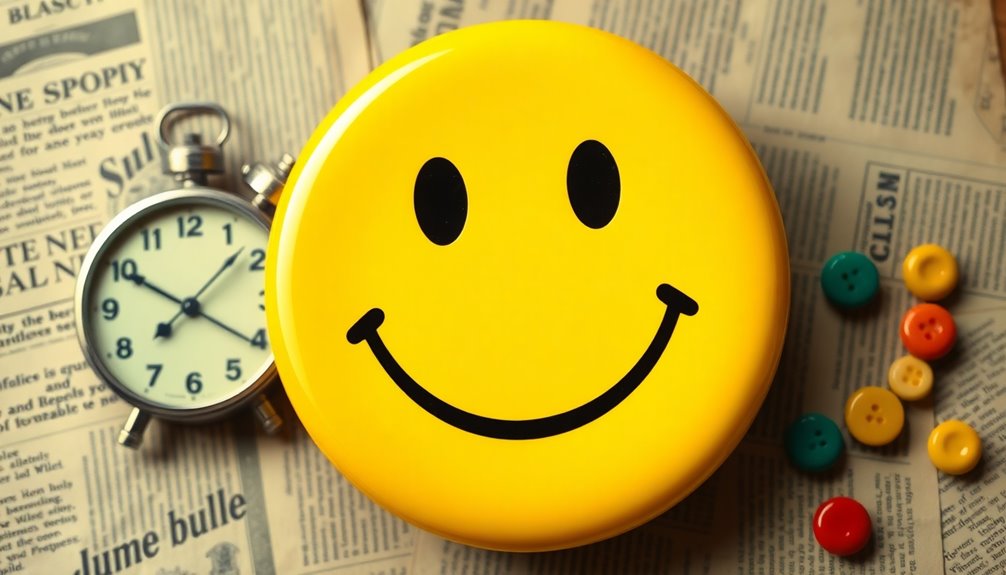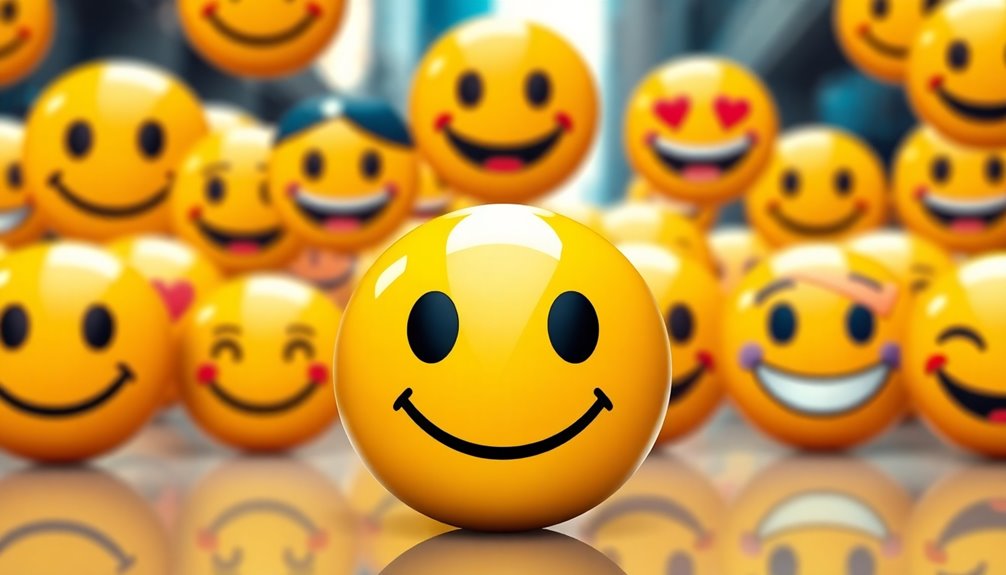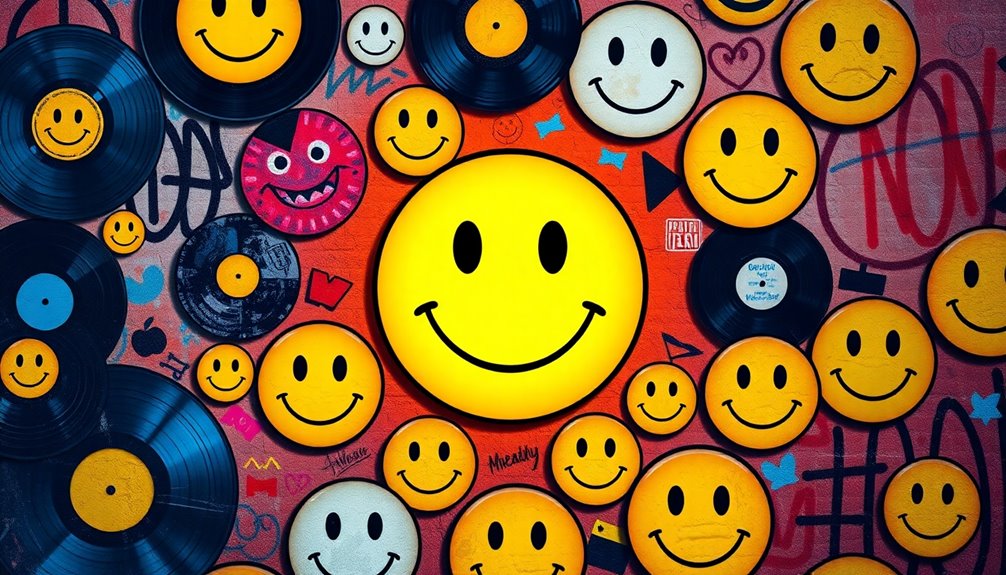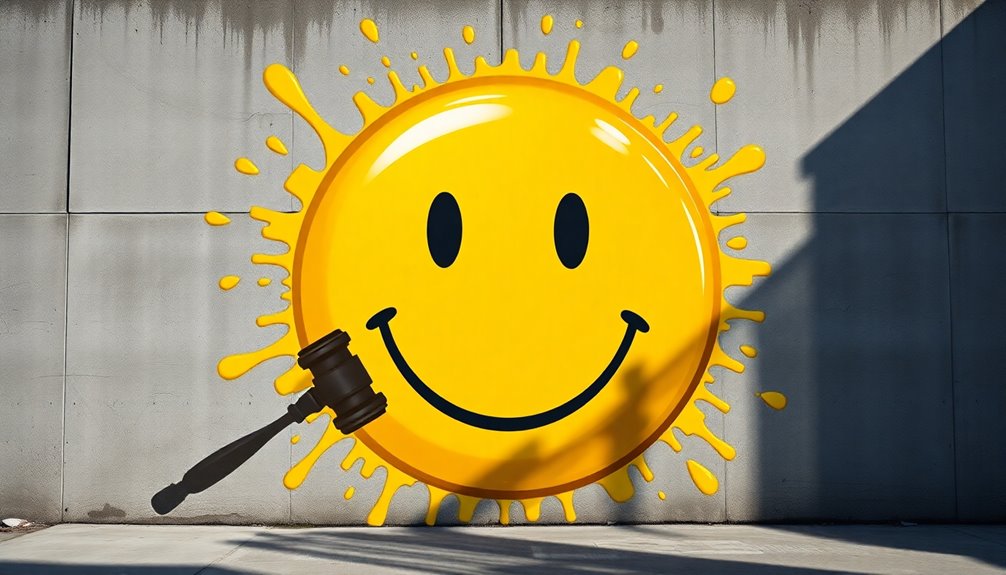The smiley face symbol has evolved notably from its ancient origins, representing joy since 1700 BCE. You might find it interesting that Harvey Ball designed the classic smiley in 1963 to uplift worker morale, and it quickly became a commercial success. Emoticons emerged in the 1980s to enhance online communication, paving the way for modern emojis that we use today. With nearly 100 smiley-based emojis reflecting our emotions, this simple icon now plays an essential role in digital interaction. If you want to explore its cultural impact and legal battles over ownership, there's much more to uncover.
Key Takeaways
- The smiley face originated around 1700 BCE, symbolizing joy in ancient civilizations, showcasing humanity's long-standing desire to convey happiness.
- Harvey Ball designed the classic smiley face in 1963, which became a commercial success, selling over 50 million buttons by 1971.
- Emoticons emerged in 1982 to clarify tone in online communication, evolving into modern emojis standardized by Unicode in 2006.
- As of 2023, nearly 100 smiley-based emojis exist, reflecting their widespread use for emotional expression across social media and messaging platforms.
- Legal disputes over the smiley face's ownership highlight its cultural significance, with The Smiley Company asserting rights in over 100 countries.
The Oldest Smiley Face
While you might think of smiley faces as a modern phenomenon, the oldest known example dates back to around 1700 BCE. Discovered by archaeologist Nicolo Marchetti in 2017, this remarkable artifact hails from the ancient Hittite civilization. The simple design features two dots for eyes and a curved line for a mouth, clearly representing joy and approval.
This smiley face is more than just an artistic expression; it's a significant piece of history that reveals how humans have long sought to convey happiness and positivity. Before this discovery, the oldest documented smiley was found on a Slovakian legal document from 1635, which also used a similar design to signify approval.
The Hittite smiley face predates that by thousands of years, highlighting the enduring cultural significance of such symbols. This ancient artifact emphasizes that the expression of joy isn't exclusive to contemporary times.
Instead, it showcases a universal human experience rooted deeply in our history. So, the next time you see a smiley face, remember its ancient origins and the long-standing tradition of sharing happiness and approval across cultures and centuries.
Birth of the Classic Smiley

You might be surprised to learn that the classic smiley face was designed in just ten minutes by Harvey Ball in 1963.
This simple yet effective design quickly caught on, leading to its commercial success and widespread replication.
Let's explore how Ball's creative process and the smiley's appeal contributed to its lasting impact.
Design Process Overview
The creation of the classic smiley face symbolized a burst of creativity that transformed simple design into a global icon of happiness. In 1963, graphic designer Harvey Ball crafted this joyful image in just ten minutes, aiming to boost employee morale at the State Mutual Life Assurance Company. The design featured a yellow circle with two black dots for eyes and a curved line for a smile, and it quickly evolved into a beloved representation of joy. Since its inception, the smiley face has transcended its original purpose, becoming a symbol of positivity and good vibes in various cultures around the world. Artists and designers have embraced the smiley face, incorporating it into diverse mediums, even experimenting with unique painting techniques with bubble wrap to create textured interpretations of the classic image. This playful exploration not only celebrates the original design but also revitalizes its message, reminding us to find joy in both art and life.
Here are three key aspects of the design process:
- Simplicity: The smiley's minimalistic design—just a yellow circle and basic facial features—made it instantly recognizable and relatable.
- Intent: Harvey Ball focused on creating a symbol that would spread joy, reflecting positivity rather than pursuing commercial gain.
- Impact: Despite not trademarking the smiley face, its design spread rapidly across various platforms, becoming a universal icon of happiness.
Harvey Ball later expressed that he'd no regrets over the lack of copyright, as his primary aim was to foster joy through the smiley face.
Commercial Success Factors
Commercial success often hinges on a mix of creativity and opportunity, and the classic smiley face is a prime example of this dynamic. Created by graphic designer Harvey Ball in 1963, the smiley face was initially designed in just ten minutes to boost employee morale for the State Mutual Life Assurance Company.
Ball's design quickly gained traction, primarily due to its entry into the public domain, which allowed for widespread distribution. By 1971, over 50 million smiley face buttons were sold, showcasing its commercial success.
The merchandising potential exploded when Bernard and Murray Spain trademarked the combination of the smiley face with the phrase "Have a Happy Day." This strategic move created a line of products that capitalized on the smiley face's growing popularity.
As the years passed, the smiley face solidified its iconic status, particularly in the late 1990s when various merchandise and fashion items featured the design, further embedding it into popular culture.
Today, the smiley face stands as a universal symbol of happiness and positivity, illustrating how creativity and timing can transform a simple design into a commercial phenomenon.
Emergence of Emoticons

In 1982, Carnegie Mellon University professor Scott Fahlman introduced the concept of emoticons to enhance online communication by clarifying tone and intent. He proposed using simple character sequences like 🙂 and 🙁 to distinguish between serious and humorous messages.
The first documented use of a smiley emoticon occurred on September 19, 1982, marking a pivotal moment in digital communication.
Emoticons quickly gained traction, especially within the CMU community, and soon spread to other universities. As their popularity grew, they paved the way for further innovations.
Here are three key developments in the emergence of emoticons:
- Standardization: In 2006, Unicode began adopting emoticons, allowing for a broader range of characters and facilitating their conversion into graphical emojis.
- Messaging Applications: The late 1990s saw the rise of messaging apps, which popularized emoticons and encouraged their use in daily conversations.
- SmileyWorld: By 2003, dedicated toolbars like SmileyWorld emerged, offering hundreds of original smiley faces to enhance your online communication.
These developments have solidified emoticons as essential elements of the digital world.
Rise of Modern Emoji

You might be surprised to learn that modern emojis trace their roots back to the late 1990s, when Japanese mobile users started creating pixelated expressions. The standardization process through Unicode has allowed these symbols to flourish, resulting in a rich cultural significance in digital communication. As you explore the evolution of emojis, you'll see how they've transformed not just texting, but also how we express emotions online. This transformation reflects the growing importance of cultural intelligence (CQ) in understanding and navigating diverse communication styles. Additionally, the rise of modern emojis parallels advancements in artificial intelligence that enhance user interaction and emotional expression in digital formats, making them a vital part of AI-driven insights in modern communication. Understanding narcissistic behavior can also inform how emojis are used in communication, as they often convey emotional nuances that might be overlooked in self-centered interactions.
Historical Context of Emoji
The evolution of digital communication has been considerably shaped by the rise of modern emoji, which began in the late 1990s when Japanese mobile phone users embraced pixelated facial expressions. This innovation quickly captured the imaginations of users worldwide, establishing a new way to convey emotions in text.
Here are three key milestones in the historical context of emoji:
- Unicode Support: In 1993, Unicode began supporting picture-like symbols, including emoji, laying the groundwork for standardized digital communication tools.
- Harvey Ball's Influence: The design of current emojis is heavily influenced by Harvey Ball's iconic yellow smiley face, which remains a recognizable cultural reference and underscores the evolution of the Smiley.
- Emoji 1.0 Release: In 2015, Unicode released Emoji 1.0, introducing over 60 smiley variations and considerably expanding the expressive potential of digital communication.
As of 2023, nearly 100 smiley-based emojis exist, with the upcoming Emoji 14.0 set to introduce seven new faces. This highlights the ongoing trends and user demands, ensuring that emojis continue to evolve alongside our communication needs.
Design and Standardization Process
Modern emoji design and standardization emerged from a blend of cultural influences and technological advancements, allowing for a universal language in digital communication. The rise of modern emoji began in the late 1990s when Japanese mobile phone users started incorporating pixelated facial expressions into their messaging systems. This early experimentation laid the groundwork for broader acceptance, as Unicode began supporting picture-like symbols in 1993.
With the release of Emoji 1.0 in 2015, Unicode introduced over 60 smiling face variations, notably expanding the emotional expression capabilities of digital communication. As of 2021, nearly 100 smiley-based emojis were available, showcasing regular updates that introduced new designs to keep pace with cultural shifts and technological changes.
The designs of current emojis continue to be influenced by the original yellow smiling face created by Harvey Ball. This iconic symbol's legacy persists, as you see its essence reflected in many contemporary emoji designs.
The unification under Unicode guarantees that these smiling faces resonate universally, bridging gaps in communication across different platforms, and making your digital conversations richer and more expressive.
Cultural Significance and Usage
Emoji's cultural significance has skyrocketed since their inception, transforming how people express emotions in digital communication. The journey began with Japanese mobile users in the late 1990s, who popularized pixelated facial expressions.
Today, emojis have evolved, reflecting cultural trends and personal expressions across the globe. Harvey Ball's iconic yellow smiley face remains a key influence, symbolizing joy and connection.
Here are three ways emojis have shaped communication:
- Enhanced Emotional Expression: Emojis allow you to convey feelings and tone that words alone often struggle to express.
- Cultural Reflection: The evolving emoji designs, supported by Unicode since 1993, showcase diverse cultural symbols and experiences, enhancing representation.
- Adaptability and Innovation: With nearly 100 smiley-based emojis available and new releases like Emoji 14.0 on the horizon, emojis continually adapt to user preferences and emerging cultural trends.
As you navigate digital conversations, emojis serve as a universal language, bridging gaps and fostering understanding. The rise of AI-driven personalization in communication tools further enhances how emojis are utilized, creating more engaging interactions.
They've become essential tools for communication, proving that a simple smiley face can carry profound meaning in our increasingly connected world.
Evolution of Emoji Popularity

Over the past few years, the rise of emoji popularity has transformed how we communicate online. With nearly 100 smiley-based emoji now available, you can express a wide range of emotions in just a tap. Since the release of Emoji 1.0 in 2015, which introduced over 60 smiley variations, emotional expression in digital communication has greatly evolved. Billions of daily uses across social media platforms and messaging apps reflect this surge in popularity.
Recent updates, like the upcoming Emoji 14.0 set featuring seven new faces, showcase how emoji adapt to cultural trends. Creative designs such as Face in Clouds and Face With Spiral Eyes keep conversations fresh and engaging. Additionally, the integration of predictive modeling in educational settings can help us understand how these symbols influence student engagement and learning outcomes.
Smiley faces and emoji have become essential tools for branding and public relations, enhancing how brands communicate with their audiences. Their universal recognition makes them powerful symbols in marketing strategies. Additionally, the integration of AI-driven storytelling techniques in digital platforms has further enhanced the use of emoji in engaging narratives.
As you navigate online interactions, remember that these tiny images pack a punch in conveying feelings and ideas, enriching your communication experience. Emoji aren't just for fun; they bridge gaps and foster connections in our increasingly digital world.
Cultural Impact of the Smiley

The smiley face has become a powerful symbol that reflects not just individual emotions but also broader cultural shifts. From its origins in the workplace during the 1960s to its role as a counterculture emblem in the 1970s, this icon has seamlessly integrated into various aspects of society.
Its cultural impact is evident in several ways:
- Marketing Prowess: The smiley face has inspired countless branding strategies, making it a staple in advertising campaigns that evoke feelings of joy and optimism.
- Artistic Influence: Artists across generations have incorporated the smiley face into their work, demonstrating its versatility and relevance in popular culture.
- Digital Evolution: As emojis took center stage in communication, the smiley face transformed into a universal message of happiness, enhancing interactions in social media and messaging platforms. This transformation parallels the rise of digital communication methods that have revolutionized how we express emotions.
This symbol's adaptability showcases its lasting relevance, resonating with diverse audiences around the globe. Additionally, its influence can be seen in the way it has been embraced by various cultural movements, reflecting changing societal attitudes towards happiness and expression.
Whether seen on merchandise or in digital formats, the smiley face embodies a shared desire for positivity, making it an enduring icon in our modern world.
Legal Battles and Ownership

Legal disputes surrounding the smiley face have shaped its ownership narrative and highlighted the complexities of trademark law. Franklin Loufrani's efforts to trademark the smiley face in the U.S. in 1997 ignited a significant legal battle with Walmart. This dispute lasted seven years, culminating in Walmart phasing out the smiley face in 2006. In 2010, both parties reached a settlement, clarifying usage rights and solidifying The Smiley Company's control over the iconic image.
The smiley face's legal journey doesn't end there. Nirvana's smiley design sparked its own copyright disputes with Marc Jacobs in 2019, illustrating ongoing challenges in ownership claims. The Smiley Company asserts rights to the smiley design in over 100 countries, boasting notable financial success and ranking among the top licensing companies globally.
| Year | Event | Outcome |
|---|---|---|
| 1997 | Loufrani trademarks smiley face | Initiated legal battle with Walmart |
| 2002 | Court case begins | Lasted seven years |
| 2006 | Walmart phases out smiley face | Due to legal complications |
| 2010 | Settlement reached | Clarified usage rights with Smiley Company |
| 2019 | Copyright dispute with Marc Jacobs | Highlights ongoing complexities in ownership |
Frequently Asked Questions
What Does Smiley Face Symbol Mean?
The smiley face symbol represents happiness and positivity. When you see it, it often evokes feelings of joy and connection. It's a simple yet powerful way to express kindness and uplift your mood.
Are Smiley Faces Universal?
Over 90% of people recognize smiley faces worldwide. Yes, smiley faces are universal. They convey happiness and positivity, transcending language barriers. You'll find them in communication, marketing, and culture, resonating with diverse audiences everywhere.
What Is the History of the Smiley Icon?
The smiley icon's history began with ancient artifacts, gained popularity through Harvey Ball's 1963 design, and evolved into a global symbol, especially in digital communication, solidifying its place as a representation of happiness.
What Is the Story Behind the Smiley Face?
Imagine a world where joy wears a simple face. Created in 1963 to uplift spirits, the smiley face soon became a beacon of happiness, representing positivity and connection, forever changing how you express joy.
Conclusion
As you scroll through your messages, each smiley face or emoji is like a tiny ambassador of emotion, bridging gaps between cultures and generations. Did you know that over 3,000 emojis now exist, each one carrying a unique story? Just as a painter uses colors to evoke feelings, you wield these symbols to express joy, love, and humor. The smiley face, once a simple doodle, has transformed into a universal language that connects us all, one pixel at a time.









